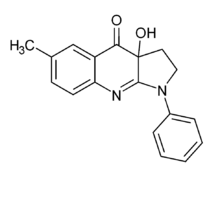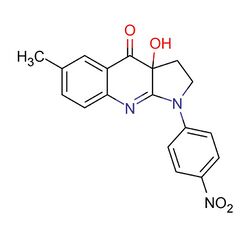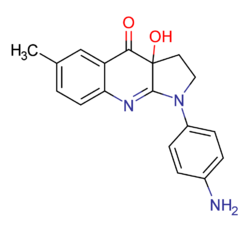Chemistry:Blebbistatin

| |
| Names | |
|---|---|
| IUPAC name
3a-Hydroxy-6-methyl-1-phenyl-2,3-dihydropyrrolo[2,3-b]quinolin-4-one
| |
| Other names
(S)-Blebbistatin, (-)-Blebbistatin
| |
| Identifiers | |
3D model (JSmol)
|
|
PubChem CID
|
|
| UNII | |
| |
| Properties | |
| C18H16N2O2 | |
| Molar mass | 292.338 g·mol−1 |
| Appearance | Yellow solid |
| 10 μM | |
Except where otherwise noted, data are given for materials in their standard state (at 25 °C [77 °F], 100 kPa). | |
| Infobox references | |
Blebbistatin is a myosin inhibitor mostly specific for myosin II.[1][2] It is widely used in research to inhibit heart muscle myosin, non-muscle myosin II, and skeletal muscle myosin. Blebbistatin has been especially useful in optical mapping of the heart,[3] and its recent use in cardiac muscle cell cultures has improved cell survival time.[4][5] However, its adverse characteristics e.g. its cytotoxicity and blue-light instability or low solubility in water often make its application challenging.[6][7] Recently its applicability was improved by chemical design and its derivatives overcome the limitations of blebbistatin.[2][8] E.g. para-nitroblebbistatin and para-aminoblebbistatin are photostable, and they are neither cytotoxic nor fluorescent.[7][9]
Mode of action and biological effects
Blebbistatin inhibits myosin ATPase activity and this way acto-myosin based motility. It binds halfway between the nucleotide binding pocket and the actin binding cleft of myosin, predominantly in an actin detached conformation.[10] This type of inhibition relaxes the acto-myosin myofilaments and leads to several biological effects.
Blebbistatin inhibits the formation of blebs in melanoma cell culture,[11] hence its name. At a cellular level, blebbistatin also inhibits cytokinesis[11] and may also disrupt mitotic spindle formation.[12] Migration of cells can be either enhanced or inhibited depending on other conditions.[13] In neurons, blebbistatin was found to promote neurite outgrowth.[14] At the organ level blebbistatin stops the contraction of skeletal muscle[15] or heart muscle.[16] Blebbistatin has also been found to stabilize the super relaxed state in the myofilaments, where myosin heads are in a helical order and interact with each other but not with actin.[17][18][19]
Adverse characteristics
A number of physicochemical deficiencies hamper the use of blebbistatin as a chemical tool in particular applications.[2]
Photo-instability
Upon blue light illumination, blebbistatin becomes inactive and phototoxic due to changes in the structure of the compound accompanied by the generation of ROS [20][6][21]
Fluorescence
Blebbistatin is a relatively strong fluorophore. When dissolved in water, it absorbs at 420 nm and emits at 490 nm however in DMSO or when perfused through cardiac tissue, it absorbs around 430 nm and emits around 560 nm,[22] therefore at high concentrations its fluorescence interferes with GFP imaging or FRET experiments.[7] Reduction of the concentration of blebbistatin to 6.25 uM allows for FRET imaging in isolated adult mouse cardiac muscle cells.[5]
Cytotoxicity
Long-term incubation with blebbistatin results in cell damage and cytotoxicity, which are independent of the myosin inhibitory effect.
This photo-instability, phototoxicity and fluorescence makes in-vivo imaging of blebbistatin-treated samples impossible.
Myosin specificity
Blebbistatin is a potent inhibitor of nonmuscle myosin IIA and IIB, cardiac myosin, skeletal myosin and smooth muscle but does not inhibit myosin I, V and X.[23][24][25] The table below summarizes IC50 data of blebbistatin on different myosin isoforms.
| species | myosin isoform or muscle type | assay type | IC50 |
|---|---|---|---|
| Dictyostelium discoideum | myosin II motor domain | basal ATPase | 2.96 ± 0.45 μM,[7] 4.4 ± 0.3 μM,[9] 4.9 μM[23] |
| Dictyostelium discoideum | myosin II motor domain | actin activated ATPase | 3.9 ± 0.3 μM[9] |
| Rabbit | skeletal muscle II | basal ATPase | 0.50 μM,[23] 0.3 ± 0.03 μM,[9] 0.41 ± 0.03 μM [7] |
| Rabbit | skeletal muscle II | actin activated ATPase | 0.11 ± 0.009 μM[9] |
| Porcine | b-cardiac muscle | basal ATPase | 1.2 μM[23] |
| Scallop | striated muscle | basal ATPase | 2.3 μM[23] |
| Human | nonmuscle IIA | basal ATPase | 5.1 μM[23] |
| Chicken | nonmuscle IIB | basal ATPase | 1.8 μM[23] |
| Human | nonmuscle IIA | actin activated ATPase | 3.58 μM[26] |
| Human | nonmuscle IIB | actin activated ATPase | 2.30 μM[26] |
| Mouse | nonmuscle IIC | actin activated ATPase | 1.57 μM[26] |
| Turkey | smooth muscle | basal ATPase | 79.6 μM[23] |
| Acanthamoeba | myosin II | basal ATPase | 83 μM[23] |
| Rat | myosin 1B | basal ATPase | >150 μM[23] |
| Acanthamoeba | myosin IC | basal ATPase | >150 μM[23] |
| Mouse | myosin V | basal ATPase | >150 μM[23] |
| Bovine | myosin X | basal ATPase | >150 μM[23] |
| smooth muscle myosin IIA heavy-chain | actin activated ATPase | 3 μM[24] | |
| smooth muscle myosin IIB heavy-chain | actin activated ATPase | 3 μM[24] | |
| Rabbit | femoral, renal and saphenous artery | tonic contraction | 5 μM[24] |
| Chicken | gizzard | contraction | 20 μM[24] |
| Chicken | gizzard smooth muscle HMM | basal ATPase | 15 ± 0.6 μM[27] |
| Chicken | gizzard smooth muscle | actin activated ATPase | 6.47 μM[26] |
| Rat | bladder | contraction | 100% inhibition at 15 μM[28] |
| Mouse | intact paced cardiac papillary muscle | contraction | 1.3 μM[29] |
| Mouse | Ca2+-activated, permeabilized cardiac papillary muscle | contraction | 2.8 μM[29] |
| Rat | skinned cardiac trabeculae | Ca2+ activated force | 0.38 ± 0.03 μM[15] |
| Rat | native demembranated right ventricular trabeculae | isometric force development | 3.17 ± 0.43 μM[30] |
| Drosophila | nonmuscle myosin-2 | actin activated ATPase | no inhibition[31] |
| Drosophila | nonmuscle myosin-2 M466I mutation | actin activated ATPase | 36.3 ± 4.1 μM[31] |
| Drosophila | cardiac tubes | heart wall motion | 100 μM resulted in full inhibition[32] |
| Starfish | nonmuscle myosin-2 | oocyte cytokinesis | effective at 300 μM[33] |
| C. elegans | nonmuscle myosin-2 | acto-myosin colocalization microscopy | effective at 100 μM [34] |
| C. elegans | nonmuscle myosin-2 | ventral enclosure | effective at 100 μM[35] |
| Podocoryna carnea (cnidarian) | nonmuscle myosin-2 | stolon tip pulsations and gastrovascular flow | effective at 255 μM[36] |
Derivatives
The main aims of the structure-activity relationship work on the blebbistatin scaffold are the improvement of the physicochemical properties and the ATPase inhibitory potency, for use as chemical or pharmacological tools. Several analogs with superior properties have been developed, and guidelines for their optimal use have been described.[2][8]
para-Nitroblebbistatin
A non-fluorescent, non-phototoxic, non-cytotoxic derivative developed in 2014.[7] Its myosin inhibitory properties are similar to those of blebbistatin (for rabbit skeletal muscle myosin S1 IC50=0.4 μM, for Dictyostelium discoideum myosin II motor domain IC50=2.3 μM, for human β-cardiac myosin subfragment 1 IC50=13 μM,[37] for heavy meromyosin fragment of chicken skeletal muscle myosin IC50=0.4 μM[37]). It has been successfully used in fluorescent imaging experiments involving myosin IIA-GFP expressing live dendritic cells[38]
para-Aminoblebbistatin
A water-soluble blebbistatin derivative developed in 2016,[9] its high water solubility (~400 uM) enables in vivo research applications. Para-aminoblebbistatin is a slightly weaker myosin inhibitor than blebbistatin (for rabbit skeletal muscle myosin S1 IC50=1.3 μM, for Dictyostelium discoideum myosin II motor domain IC50=6.6 μM with only 90% maximal inhibition), it is non-fluorescent, photostable, neither cytotoxic nor phototoxic.
Azidoblebbistatin
A photoreactive myosin inhibitor developed in 2012.[39] A permanent inhibition of myosin may be achieved by covalently crosslinking the inhibitor azidoblebbistatin to its target by photoaffinity labeling (PAL). Briefly, upon UV illumination, the aryl-azide moiety in azidoblebbistatin forms a reactive nitrene.[40] This reaction is utilized to form covalent link between the inhibitor and myosin.
Azidoblebbistatin is also sensitive to two-photon irradiation, i.e. the covalent crosslink may also be generated by two-photon excitation microscope, therefore azidoblebbistatin is suitable for molecular tattooing.[41]
(S)-Nitroblebbistatin
This derivative was developed in 2005 to increase the photostability and decrease the fluorescence of blebbistatin.[42] (S)-nitro-blebbistatin is indeed stable to prolonged irradiation at 450-490 nm and has been successfully used in fluorescent live cell imaging.[43] However its affinity to myosin significantly decreased with the nitro-substitution (for nonmuscle myosin IIA, the IC50 = 27 μM).[42] In many cases due to the low solubility, it is not possible to achieve full inhibition of myosin with (S)-nitro-blebbistatin. It is effective for FRET imaging of isolated adult mouse cardiac muscle cells.[5]
(+)-Blebbistatin
(+)-Blebbistatin (or (R)-blebbistatin) is the inactive enantiomer of blebbistatin[1] which inhibits the ATPase activity by maximum 10%.[44] In research, it is useful compound for control treatment, to check the non-myosin related toxic effects of blebbistatin.
Other derivatives
The blebbistatin scaffold has been modified in several ways to optimize myosin isoform specificity or to improve the inhibitory properties and to map the structure-activity relationship. Major steps in the optimization include the work of Lucas-Lopez et al. from 2008[45] and the works of Verhasselt et al. from 2017.[46][47][48][49] The latter studies also include modifications of the A- and C-rings of the scaffold.
para-Chloroblebbistatin
A photostable, non-fluorescent, phototoxic derivative. Its fluorescence is less than 1% of that of blebbistatin myosin inhibitory properties are similar to those of blebbistatin. It is even more phototoxic than blebbistatin.[7]
References
- ↑ 1.0 1.1 "Dissecting temporal and spatial control of cytokinesis with a myosin II Inhibitor". Science 299 (5613): 1743–7. March 2003. doi:10.1126/science.1081412. PMID 12637748. Bibcode: 2003Sci...299.1743S.
- ↑ 2.0 2.1 2.2 2.3 "Medicinal Chemistry and Use of Myosin II Inhibitor ( S)-Blebbistatin and Its Derivatives". Journal of Medicinal Chemistry 61 (21): 9410–9428. June 2018. doi:10.1021/acs.jmedchem.8b00503. PMID 29878759.
- ↑ "Properties of blebbistatin for cardiac optical mapping and other imaging applications". Pflügers Archiv 464 (5): 503–12. November 2012. doi:10.1007/s00424-012-1147-2. PMID 22990759.
- ↑ "Blebbistatin extends culture life of adult mouse cardiac myocytes and allows efficient and stable transgene expression". American Journal of Physiology. Heart and Circulatory Physiology 294 (4): H1667–74. April 2008. doi:10.1152/ajpheart.01144.2007. PMID 18296569.
- ↑ 5.0 5.1 5.2 Reddy, Gopireddy Raghavender; West, Toni M.; Jian, Zhong; Jaradeh, Mark; Shi, Qian; Wang, Ying; Chen-Izu, Ye; Xian g, Yang K. (2018-09-21). "Illuminating cell signaling with genetically encoded FRET biosensors in adult mouse cardiomyocytes" (in en). The Journal of General Physiology 150 (11): 1567–1582. doi:10.1085/jgp.201812119. PMID 30242036.
- ↑ 6.0 6.1 "Phototoxicity and photoinactivation of blebbistatin in UV and visible light". Biochemical and Biophysical Research Communications 320 (3): 1020–5. July 2004. doi:10.1016/j.bbrc.2004.06.045. PMID 15240150.
- ↑ 7.0 7.1 7.2 7.3 7.4 7.5 7.6 "para-Nitroblebbistatin, the non-cytotoxic and photostable myosin II inhibitor". Angewandte Chemie 53 (31): 8211–5. July 2014. doi:10.1002/anie.201403540. PMID 24954740.
- ↑ 8.0 8.1 "Targeting Myosin by Blebbistatin Derivatives: Optimization and Pharmacological Potential". Trends in Biochemical Sciences 43 (9): 700–713. September 2018. doi:10.1016/j.tibs.2018.06.006. PMID 30057142.
- ↑ 9.0 9.1 9.2 9.3 9.4 9.5 "A highly soluble, non-phototoxic, non-fluorescent blebbistatin derivative". Scientific Reports 6: 26141. May 2016. doi:10.1038/srep26141. PMID 27241904. Bibcode: 2016NatSR...626141V.
- ↑ "Mechanism of blebbistatin inhibition of myosin II". The Journal of Biological Chemistry 279 (34): 35557–63. August 2004. doi:10.1074/jbc.M405319200. PMID 15205456.
- ↑ 11.0 11.1 "A small-molecule inhibitor of skeletal muscle myosin II". Nature Cell Biology 4 (1): 83–8. January 2002. doi:10.1038/ncb734. PMID 11744924.
- ↑ "Myosin II-dependent cortical movement is required for centrosome separation and positioning during mitotic spindle assembly". Cell 117 (3): 361–72. April 2004. doi:10.1016/s0092-8674(04)00341-1. PMID 15109496.
- ↑ "Facile preparation of a photoactivatable surface on a 96-well plate: a versatile and multiplex cell migration assay platform". Physical Chemistry Chemical Physics 17 (21): 14159–67. June 2015. doi:10.1039/c5cp01499a. PMID 25959431. Bibcode: 2015PCCP...1714159K.
- ↑ "Myosin II activity regulates neurite outgrowth and guidance in response to chondroitin sulfate proteoglycans". Journal of Neurochemistry 120 (6): 1117–28. March 2012. doi:10.1111/j.1471-4159.2011.07638.x. PMID 22191382.
- ↑ 15.0 15.1 "Blebbistatin: use as inhibitor of muscle contraction". Pflügers Archiv 455 (6): 995–1005. March 2008. doi:10.1007/s00424-007-0375-3. PMID 17994251.
- ↑ "Application of blebbistatin as an excitation-contraction uncoupler for electrophysiologic study of rat and rabbit hearts". Heart Rhythm 4 (5): 619–26. May 2007. doi:10.1016/j.hrthm.2006.12.047. PMID 17467631.
- ↑ "Blebbistatin stabilizes the helical order of myosin filaments by promoting the switch 2 closed state". Biophysical Journal 95 (7): 3322–9. October 2008. doi:10.1529/biophysj.108.137067. PMID 18599626. Bibcode: 2008BpJ....95.3322Z.
- ↑ "Stabilization of helical order in the thick filaments by blebbistatin: further evidence of coexisting multiple conformations of myosin". Biophysical Journal 96 (9): 3673–81. May 2009. doi:10.1016/j.bpj.2009.01.049. PMID 19413972. Bibcode: 2009BpJ....96.3673X.
- ↑ "The myosin inhibitor blebbistatin stabilizes the super-relaxed state in skeletal muscle". Biophysical Journal 107 (7): 1637–46. October 2014. doi:10.1016/j.bpj.2014.07.075. PMID 25296316. Bibcode: 2014BpJ...107.1637W.
- ↑ "Blebbistatin, a myosin II inhibitor, is photoinactivated by blue light". Biochemistry 44 (2): 584–8. January 2005. doi:10.1021/bi0483357. PMID 15641783.
- ↑ "Blebbistatin, a myosin inhibitor, is phototoxic to human cancer cells under exposure to blue light". Biochimica et Biophysica Acta (BBA) - General Subjects 1820 (7): 870–7. July 2012. doi:10.1016/j.bbagen.2012.04.003. PMID 22507270.
- ↑ "Properties of blebbistatin for cardiac optical mapping and other imaging applications". Pflügers Archiv 464 (5): 503–12. November 2012. doi:10.1007/s00424-012-1147-2. PMID 22990759.
- ↑ 23.00 23.01 23.02 23.03 23.04 23.05 23.06 23.07 23.08 23.09 23.10 23.11 23.12 "Specificity of blebbistatin, an inhibitor of myosin II". Journal of Muscle Research and Cell Motility 25 (4–5): 337–41. 2004-01-01. doi:10.1007/s10974-004-6060-7. PMID 15548862. https://zenodo.org/record/1232816.
- ↑ 24.0 24.1 24.2 24.3 24.4 "Potent inhibition of arterial smooth muscle tonic contractions by the selective myosin II inhibitor, blebbistatin". The Journal of Pharmacology and Experimental Therapeutics 320 (2): 865–70. February 2007. doi:10.1124/jpet.106.109363. PMID 17132816.
- ↑ "Blebbistatin, a myosin II inhibitor, suppresses Ca(2+)-induced and "sensitized"-contraction of skinned tracheal muscles from guinea pig". Journal of Smooth Muscle Research = Nihon Heikatsukin Gakkai Kikanshi 49: 89–98. 2013. doi:10.1540/jsmr.49.89. PMID 24662474.
- ↑ 26.0 26.1 26.2 26.3 "Characterization of Blebbistatin Inhibition of Smooth Muscle Myosin and Nonmuscle Myosin-2". Biochemistry 56 (32): 4235–4243. August 2017. doi:10.1021/acs.biochem.7b00311. PMID 28714309.
- ↑ "Blebbistatin inhibits the chemotaxis of vascular smooth muscle cells by disrupting the myosin II-actin interaction". American Journal of Physiology. Heart and Circulatory Physiology 294 (5): H2060–8. May 2008. doi:10.1152/ajpheart.00970.2007. PMID 18296570.
- ↑ "Blebbistain, a myosin II inhibitor, as a novel strategy to regulate detrusor contractility in a rat model of partial bladder outlet obstruction". PLOS ONE 6 (10): e25958. 2011-10-07. doi:10.1371/journal.pone.0025958. PMID 22016792. Bibcode: 2011PLoSO...625958Z.
- ↑ 29.0 29.1 "Blebbistatin specifically inhibits actin-myosin interaction in mouse cardiac muscle". American Journal of Physiology. Cell Physiology 293 (3): C1148–53. September 2007. doi:10.1152/ajpcell.00551.2006. PMID 17615158.
- ↑ "Omecamtiv mercabil and blebbistatin modulate cardiac contractility by perturbing the regulatory state of the myosin filament". The Journal of Physiology 596 (1): 31–46. January 2018. doi:10.1113/jp275050. PMID 29052230.
- ↑ 31.0 31.1 "Kinetic characterization of the sole nonmuscle myosin-2 from the model organism Drosophila melanogaster". FASEB Journal 29 (4): 1456–66. April 2015. doi:10.1096/fj.14-266742. PMID 25636739.
- ↑ "A Drosophila melanogaster model of diastolic dysfunction and cardiomyopathy based on impaired troponin-T function". Circulation Research 114 (2): e6–17. January 2014. doi:10.1161/CIRCRESAHA.114.302028. PMID 24221941.
- ↑ Bischof, Johanna. "The Molecular Mechanism of Surface Contraction Waves in the Starfish Oocyte". https://archiv.ub.uni-heidelberg.de/volltextserver/21578/1/Dissertation%20Johanna%20Bischof_18072016.pdf.
- ↑ "UNC-45 is required for NMY-2 contractile function in early embryonic polarity establishment and germline cellularization in C. elegans". Developmental Biology 314 (2): 287–99. February 2008. doi:10.1016/j.ydbio.2007.11.028. PMID 18190904.
- ↑ Wernike, Denise. "Studying Ventral Enclosure during C. elegans Epidermal Morphogenesis". https://spectrum.library.concordia.ca/980449/1/Wernike_PhD_F2015.pdf.
- ↑ "The Selective Myosin II Inhibitor Blebbistatin Reversibly Eliminates Gastrovascular Flow and Stolon Tip Pulsations in the Colonial Hydroid Podocoryna carnea". PLOS ONE 10 (11): e0143564. 2015-11-25. doi:10.1371/journal.pone.0143564. PMID 26605798. Bibcode: 2015PLoSO..1043564C.
- ↑ 37.0 37.1 "Modulating Beta-Cardiac Myosin Function at the Molecular and Tissue Levels". Frontiers in Physiology 7: 659. 2017. doi:10.3389/fphys.2016.00659. PMID 28119616.
- ↑ "Cell migration and antigen capture are antagonistic processes coupled by myosin II in dendritic cells.". Nature Communications 6: 7526. June 2015. doi:10.1038/ncomms8526. PMID 26109323. Bibcode: 2015NatCo...6.7526C.
- ↑ "Azidoblebbistatin, a photoreactive myosin inhibitor". Proceedings of the National Academy of Sciences of the United States of America 109 (24): 9402–7. June 2012. doi:10.1073/pnas.1202786109. PMID 22647605. Bibcode: 2012PNAS..109.9402K.
- ↑ "Photoreactive Crosslinker Chemistry". https://www.thermofisher.com/hu/en/home/life-science/protein-biology/protein-biology-learning-center/protein-biology-resource-library/pierce-protein-methods/photoreactive-crosslinker-chemistry.html.
- ↑ "Molecular tattoo: subcellular confinement of drug effects". Chemistry & Biology 22 (4): 548–558. April 2015. doi:10.1016/j.chembiol.2015.03.013. PMID 25892202.
- ↑ 42.0 42.1 Lucas-Lopez, Cristina; Patterson, Stephen; Blum, Till; Straight, Aaron F.; Toth, Judit; Slawin, Alexandra M. Z.; Mitchison, Timothy J.; Sellers, James R. et al. (2005-05-01). "Absolute Stereochemical Assignment and Fluorescence Tuning of the Small Molecule Tool, (–)-Blebbistatin" (in en). European Journal of Organic Chemistry 2005 (9): 1736–1740. doi:10.1002/ejoc.200500103.
- ↑ "The myosin II ATPase inhibitor blebbistatin prevents thrombin-induced inhibition of intercellular calcium wave propagation in corneal endothelial cells". Investigative Ophthalmology & Visual Science 49 (11): 4816–27. November 2008. doi:10.1167/iovs.07-1533. PMID 18614806.
- ↑ Lucas-Lopez, Cristina. "Supportin information for the article "Absolute Stereochemical Assignment and Fluorescence Tuning of the Small Molecule Tool, (–)-Blebbistatin"". https://application.wiley-vch.de/contents/jc_2046/2005/o200500103_s.pdf.
- ↑ "The small molecule tool (S)-(-)-blebbistatin: novel insights of relevance to myosin inhibitor design". Organic & Biomolecular Chemistry 6 (12): 2076–84. June 2008. doi:10.1039/b801223g. PMID 18528569.
- ↑ "Discovery of (S)-3'-hydroxyblebbistatin and (S)-3'-aminoblebbistatin: polar myosin II inhibitors with superior research tool properties". Organic & Biomolecular Chemistry 15 (9): 2104–2118. March 2017. doi:10.1039/c7ob00006e. PMID 28220174. https://biblio.ugent.be/publication/8514040.
- ↑ "Improved synthesis and comparative analysis of the tool properties of new and existing D-ring modified (S)-blebbistatin analogs". European Journal of Medicinal Chemistry 136: 85–103. August 2017. doi:10.1016/j.ejmech.2017.04.072. PMID 28486210. https://biblio.ugent.be/publication/8519711.
- ↑ "Insights into the myosin II inhibitory potency of A-ring-modified (S)-blebbistatin analogs". Bioorganic & Medicinal Chemistry Letters 27 (13): 2986–2989. July 2017. doi:10.1016/j.bmcl.2017.05.008. PMID 28512027. https://biblio.ugent.be/publication/8519713/file/8519727.pdf.
- ↑ "Synthesis of C-ring-modified blebbistatin derivatives and evaluation of their myosin II ATPase inhibitory potency". Bioorganic & Medicinal Chemistry Letters 28 (13): 2261–2264. July 2018. doi:10.1016/j.bmcl.2018.05.041. PMID 29807794.
 |



